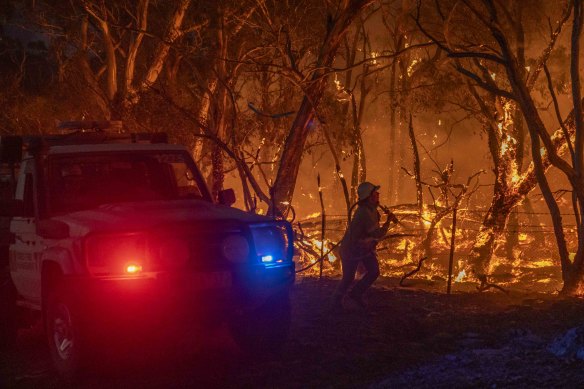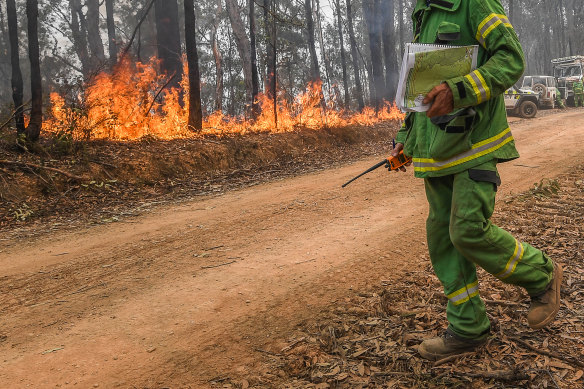- Exclusive
- Politics
- Victoria
- Victoria bushfires
This was published 5 months ago
Forest fire redundancies ‘risk emergency responses’
By Rachel Eddie
Victorian towns devastated in the deadly Black Saturday blazes are at risk of being exposed again in an emergency under a proposed restructure of the forest fire workforce that will close depots, the Australian Workers Union has warned.
The Department of Energy, Environment and Climate Action (DEECA) is planning to make 208 people redundant in its bushfire and forest services group, including 118 in forest fire operations – a move the department acknowledges could risk its contribution to emergency management in the short to medium term.

Victoria’s environment department is looking to make 208 people redundant in its bushfire and forest services group, including 118 in forest fire operations.Credit: Forest Fire Management Victoria
Many of those working back-of-house at the department also have a frontline role fighting fires and in other emergencies through Forest Fire Management Victoria (FFMVic).
The AWU is now considering joining the Community and Public Sector Union (CPSU) as it takes the state government to the Fair Work Commission over the cuts.
Under its plan, DEECA is also looking to close some of its 99 regional work centres to cut costs and redirect funds to higher risk areas – but the AWU has warned that would leave gaps in coverage during emergencies.
“The proposed closure of the Lysterfield and Plenty Gorge work centres will also leave geographical gaps in coverage for emergency response,” the union said in its formal response – obtained by The Age – to the department this month.
The AWU said the closure of DEECA’s Kinglake work centre would leave “significantly less coverage in areas that were greatly impacted by the Black Saturday fires”.
The 2009 Black Saturday bushfires killed 173 people in Victoria and burnt through more than 400,000 hectares.
Nathalia, in the state’s north, in particular needed equipment and variable staff for emergencies and to retain response times, the union said. New satellite depots may also be necessary as they close other sites, it said.
Under DEECA’s proposal, frontline field staff would be bolstered with 54 extra workers.

DEECA says no frontline firefighting roles are being reduced under its planned restructure.Credit: DEECA
But the AWU said some “new” positions were existing back-of-house jobs shifted onto the lower-paid field workforce – not the promised extra resources. Given some field staff roles were also being cut, the union has asked for a breakdown to get a better understanding of total new jobs.
Lead organiser Ross Kenna said the AWU was considering lodging a dispute with Fair Work.
The CPSU has already done so, with a hearing listed for Friday. That union, which claimed the department had failed to meaningfully consult on the changes, also said its members would be disadvantaged by their existing work shifting into lower-paid field positions.
The forest fire operations team – where 118 jobs could be lost – “delivers integrated land and fire management activities across state forests”, according to department documents.
As part of FFMVic, the division also undertakes “bushfire management across all public land in Victoria, and supports other Class 1 and Class 2 emergencies”, which have the potential to be, or are, deadly.
Consultation documents circulated to staff in August – also obtained by The Age – acknowledged that cutting this division “may reduce ability in the short to medium term to contribute to sector-wide [emergency management] arrangements”.
This was especially true for cross-district taskforces, particularly non-fire emergencies and incident management team roles in which DEECA is not the control agency. “However, the seasonal [emergency management] workforce framework will help mitigate this risk,” the document said.
It said the change would streamline planning and result in better integration of forest and fire management.
In total, the bushfire and forest services group will drop from 1925 staff to 1717. Other proposed cuts include 34 workers in the conservation regulator, 36 in infrastructure and resources, and 20 in policy and planning.
The department said it had not reviewed its operations since 2017 and that its role had changed when the Parks Victoria fire program was transferred to DEECA, and since the ban on native timber logging.
The department, which will finalise the restructure this month, also has a role managing the bird flu outbreak and responding to floods and storms.
Parks Victoria is also in the early stages of a possible restructure.
A government spokeswoman said the 54 new forest firefighter roles at FFMVic would be funded through a $36.9 million investment, and that $20 million would upgrade critical forest fire emergency equipment.
“Our capacity to deliver bushfire management works or respond in an emergency has not changed – there is no decrease in the number of field staff under these proposed changes,” she said.
DEECA deputy secretary Kelly Crosthwaite said it was working through feedback on the proposed operating model that would “deliver value for taxpayers and make sure we have the right people working on the right things”.
“No frontline firefighting roles are being reduced – in fact, we’re adding more full-time operational roles – and our incident management capacity and regional presence will be maintained. Victorians can be assured we’ll continue to protect communities and the things they care about from bushfire risk.”
On Thursday, Emergency Services Minister Jaclyn Symes said Victoria should prepare for an early start to the fire season in the west of the state after a dry winter.
She said the rest of the state could be described as facing a normal fire season, but that this could change if Victoria didn’t get much rain by January.
Symes said a wild hail storm in Casterton in Victoria’s west on Wednesday night was an example of localised weather events becoming more frequent and severe with climate change.
Start the day with a summary of the day’s most important and interesting stories, analysis and insights. Sign up for our Morning Edition newsletter.